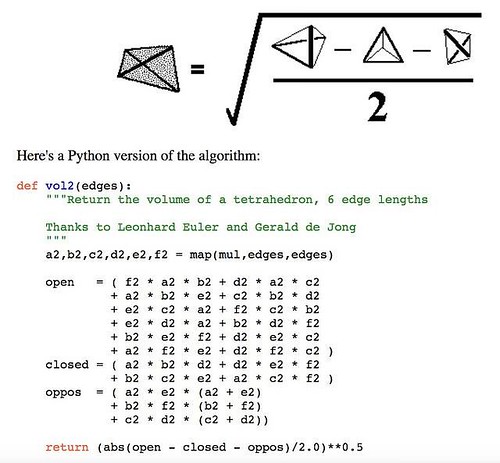During the hallway track (what we call people milling about, randomly engaging one another), I had a couple of opportunities to chat up Martian Math.
I was wearing my 4D Solutions name tag. One guy asked what additional dimension I brought to the table, clearly thinking in terms of "3D + what?". We're of course trained to answer "time" and that's legit, however my readers know I go in another direction.
My other discussion was with Peter Scott who wrote the Perl curriculum for O'Reilly School (which exists no longer). Perl 6 is finally available for download, and is a whole different language. This year's OSCON was not a catapult for specific languages, except maybe Rust.
Sponsors wanted to talk about what they're doing (often collaboratively) around blockchains and such. IBM has been working on several flavors of hyperledger.
I told both my first inquisitor, and Peter, about Caltrop Coordinates. Rays emanate from a common origin, with unit vectors being of definite length i.e. like rays but short. We have a way to reach points by cloning, scaling and adding unit vectors, sticking them end to end.
In XYZ, the three basis vectors
i,
j,
k define like an eighth octahedron, a volume, and through cloning, scaling and concatenation, they span much of space. I think of any three non-coplanar edges of a tetrahedron, a zig-zag: that's 3D too, with the complementary zig-zag implicit.
Just looking at a tetrahedron (of two complementary 3-vector zig-zags), do we want to call that 3D or 4D?
The four tips and four faces suggest "four directional" but then all these directions are codependent if we think of the tetrahedron is a symbol for "any containment". In the philosophical language of Synergetics, height, width and depth only coexist as contained within an
a priori 4D space. That's before we add time (frequency, subdivisions).
Best practice within the XYZ language game is to admit a kind of rotation called negation which begets 180 degree mirror vectors
-i, -
j, -
k. Now we have the customary eight octants of XYZ space.
XYZ is more like a jack, with six vectors emanating from a common origin.
Quadrays are similar to XYZ except instead of admitting rotation (negation) so soon, we add one more basis vector to the initial three and adjust their respective directions to define four quadrants (versus XYZ's eight octants).
Instead of a jack, we get the caltrop. The basis vectors go from (0,0,0,0) to the four corners of a tetrahedron: (1,0,0,0), (0,1,0,0), (0, 0,1,0) and (0,0,0,1). Space is 4D in this sense.
Linear combinations (cloning and scaling) now reach all the same points XYZ does, but with positive 4-tuples e.g. (2,1,1,0) (1,2,1,0) (1,1,2,0)... all twelve permutations of those numbers define the twelve corners of a cuboctahedon.
Because we're using four basis vectors instead of three, we tend to say space is 4D. We might say 3D too though, as XYZ language is not out of bounds. We may rely on context, using customary locutions to convey our meanings.
In XYZ language, we would
not say all four quadrays are "basis vectors" because one of them (any one) is a linear combination of the the other three. If, that is, we allow negation as a part of our cloning, scaling and tip-to-tail addition process.
Add any three quadrays and flip the result to get the fourth. In other words:
(1,0,0,0) +
(0,1,0,0) +
(0,0,1,0) =
(1,1,1,0)
and
-(1,1,1,0) =
(-1,-1,-1,0) =
(0,0,0,1).
In the shoptalk of Quadrays, negation (flipping direction) is certainly defined and allowed, but is not required to span space (by means of cloning, scaling, adding) nor to augment the basis vector set.
Scaling without negation just means adjusting a length, making it longer or shorter but with no change in direction. Negation adds the directional flip.
We can flip Quadrays, however the four basis rays are independent of one another in the sense that no three create the fourth without flipping i.e. through scaling and adding alone.
On the other hand, we may say four quadrays are "codependent" in that the tetrahedron is our primitive conceptual beginning, a first otherness begetting awareness. Conceptualization begins with containment, a sense of being "within" or "without" (cite Plato's Cave). XYZ uses a cube as its corresponding hallmark.
"That's a really geeky answer" said the geek by the food truck, awaiting his burrito (as I was). I nodded. We were there to geek out.





















